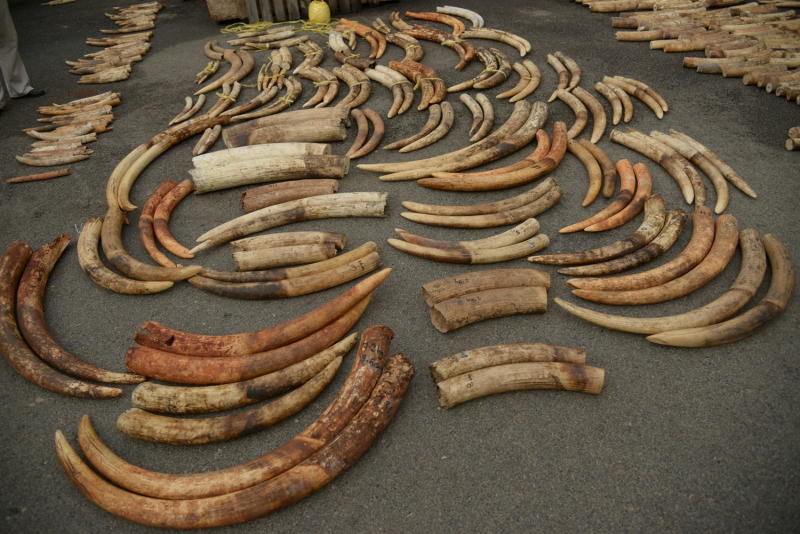Ivory from Africa mainly taken from elephants in same area, study shows
Sign up now: Get ST's newsletters delivered to your inbox

Ivory trafficking is illegal and is causing elephant populations to decline.
PHOTO: REUTERS
Follow topic:
SINGAPORE - Elephant ivory smuggled out of Africa over the past decade or so came mainly from elephants found in the same area, and sometimes even the same herd, a new study involving Singapore researchers has found.
This finding, published in the Nature Human Behaviour scientific journal on Tuesday morning Singapore time (Feb 15), could lead to greater protection of elephants in poaching hot spots, and also help the authorities identify links between shipments and disrupt the transnational smuggling ring behind them.
By studying the genetic material in tusks from 49 ivory shipments weighing 111 tonnes leaving Africa between 2002 and 2019, the international scientific team found that the majority of them came from the same localised elephant populations.
Scientists can determine this by first sequencing the genetic material in the tusks, and then seeing if the sequences matched.
Matched sequences mean both tusks came from the same elephant, while similar sequences indicate that they were likely from the same herd.
This work had built on an earlier effort led by conservation biologist Samuel Wasser of the University of Washington.
Professor Wasser, who is one of the authors of the latest study, had earlier developed a database that "matched" the elephant genetic sequences from their faeces to the areas where the creatures roam.
Of the 49 shipments studied, one of them had been picked up in Singapore and seized in July 2019 by the National Parks Board (NParks), Singapore Customs and Immigration and Checkpoints Authority.
A record haul of 8.8 tonnes of raw elephant ivory worth about $17.6 million were seized then, with the authorities estimating that the tusks had come from almost 300 African savannah elephants (Loxodonta africana), which are endangered animals.
Other shipments came from countries including Hong Kong, Kenya, Malaysia, the Philippines, Sri Lanka, Thailand, and Vietnam.
Researchers at the NParks' Centre for Wildlife Forensics had collected and analysed more than 230 tusk samples from this seizure with Prof Wassler.
Two NParks staff from the centre, Dr Anna Wong and Dr Charlene Fernandez, are co-authors of the latest study.
Dr Adrian Loo, group director of wildlife management at NParks, said a majority of tusks in the Singapore seizure were from elephants poached in the Kavango-Zambezi Trans Frontier Conservation Area.
He added: "Several other seizures also contained tusks from elephants poached in the same area, suggesting that the Kavango-Zambezi Trans Frontier Conservation Area is a potentially new and emerging poaching hot spot."
This area, nearly twice as large as Britain, lies in the Kavango and Zambezi river basins, where Angola, Botswana, Namibia, Zambia and Zimbabwe converge.
"These findings provide a deeper understanding of the criminal networks and their modus operandi in source countries. This will enable the international community to strengthen and direct more focused enforcement and prosecution efforts to counter wildlife trafficking," Dr Loo said.
Transnational criminal organisations often consolidate raw ivory and ship it out of a different African country from where the elephants are poached, the researchers said in the paper.
But genetic analyses of the tusks will allow law enforcement agencies to establish links between tusks found in the separate seizures, and where the ivory shipments originated.
"Such tools can connect individual transnational criminal organisations to multiple large ivory seizures of forest and savannah elephants, while also showing connections between organisations operating out of different ports," they said.
"With the added evidence of these genetic data, arrests made on the basis of a single ivory seizure may result in prosecution for multiple linked shipments, leading to more serious penalties for the criminals responsible."
This can help to disrupt and dismantle transnational criminal organisations responsible for exporting large volumes of ivory out of Africa, they added.
"Targeting such organisations could substantially reduce the amount of ivory entering transit… It would also eliminate the principal source of income to poachers and the middlemen who move the ivory up the illicit supply chain before consolidation," the authors said.
Ivory trafficking is illegal and is causing elephant populations to decline.
While Singapore is not a major source of demand for such illegal wildlife products, the country has been urged by conservation groups worldwide to do more in its role as a transshipment hub to stamp out the trade.
The Singapore authorities have intercepted a number of large shipments of illegal wildlife products, including elephant ivory and pangolin scales, in recent years.
Other than the record 8.8 tonnes of elephant ivory seized in July 2019, the Republic also uncovered, within a span of a week, two shipments of pangolin scales weighing 25.6 tonnes in April that year.
In 2020, Singapore crushed the 8.8 tonnes of ivory it seized in 2019, live-streaming the process to demonstrate its zero-tolerance stance against wildlife trafficking. Samples from the ivory had been extracted before the crush.
Last August, NParks opened the Centre for Wildlife Forensics as the first national facility for wildlife forensics.
Dr Loo said the centre leverages science and technology to investigate cases of illegal wildlife trade, enhancing NParks' testing capabilities to accurately identify and analyse wildlife and wildlife products.
He added: "Such use of forensic science will also help to produce evidence that support law enforcement and prosecution."
Dr Madhu Rao, who is the director and regional technical adviser at the environmental group Wildlife Conservation Society, said the latest study could help conservationists and law enforcement officials understand the wider supply chains for ivory and identify poaching hot spots.
“Genetic analyses such as these, together with intelligence information, can contribute significantly to strengthening enforcement action, cracking down on poaching and to higher prosecution rates for traffickers,” she said.
“It is important to ensure that data and methodological approaches are transparently and widely shared if we want such tools to truly benefit elephant conservation.”

